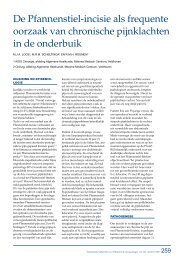Surgical management of chronic inguinal pain syndromes - Liespijn
Surgical management of chronic inguinal pain syndromes - Liespijn
Surgical management of chronic inguinal pain syndromes - Liespijn
You also want an ePaper? Increase the reach of your titles
YUMPU automatically turns print PDFs into web optimized ePapers that Google loves.
SUMMARIZING DISCUSSION1. Prevalence and risk factors <strong>of</strong> <strong>chronic</strong> <strong>pain</strong> after routine <strong>inguinal</strong> surgery‘Routine’ operations such as <strong>inguinal</strong> herniorrhaphy and Pfannenstiel incisions forcesarean deliveries may inflict patients with unacceptable high rates <strong>of</strong> severe <strong>chronic</strong><strong>pain</strong> 1,2 . To investigate the <strong>chronic</strong> <strong>pain</strong> morbidity caused by <strong>inguinal</strong> hernioplasty in alarge patient cohort, a questionnaire concerning frequency and intensity <strong>of</strong> <strong>pain</strong>, numbnessand functional impairment was composed (chapter 2). 1766 questionnaires werereturned (response 81.6%) and after a median follow-up period <strong>of</strong> three years 40.2% <strong>of</strong>patients reported some degree <strong>of</strong> <strong>pain</strong>. Thirty-three patients (1.9%) experienced severe<strong>pain</strong>. One fifth <strong>of</strong> the patients felt functionally impaired in their work or leisure activities.Chronic <strong>pain</strong> and functional impairment are apparently very common long-termcomplications after <strong>inguinal</strong> herniorrhaphy. Apart from our study, several assessments<strong>of</strong> <strong>chronic</strong> postherniorrhaphy <strong>pain</strong> have been performed by others in recent years.According to a recently published review some 11% <strong>of</strong> patients suffer from <strong>chronic</strong> <strong>pain</strong>after a mesh-based repair 3 . This discrepancy with our study (40.2%) is probably due tothe fact that many patients with only minor discomfort are included in our ‘<strong>pain</strong> group’as well.Almost one-fourth <strong>of</strong> the patients with <strong>pain</strong> reported numbness as a risk factor. Othervariables associated with the development <strong>of</strong> <strong>pain</strong> were age and recurrent hernia repair.One can classify risk factors as patient- or surgery-related factors. Patient-related issuesare age, occurrence <strong>of</strong> any postoperative complication, and high levels <strong>of</strong> pre- and directpostoperative <strong>pain</strong> 4 . High <strong>pain</strong> levels appear to predispose for <strong>chronic</strong>ity <strong>of</strong> <strong>pain</strong> symptoms5 . A genetic susceptibility for <strong>pain</strong> may be the underlying mechanism 6 . Furthermore,psychosocial characteristics may also act as patient-related risk factors. Normal<strong>pain</strong> perception partly relies on adequate coping behaviour 7 . On the other hand,research has also identified surgery-related factors such as nerve handling (preservationversus prophylactic neurectomy). However, prophylactic neurectomy <strong>of</strong> the ilio<strong>inguinal</strong>nerve does not always seem to prevent <strong>chronic</strong> <strong>pain</strong> 7-9 . Possibly all other remaining<strong>inguinal</strong> nerves need to be neurectomized prophylactically as well. Second, surgicaltechnique may also play a role in the onset <strong>of</strong> <strong>pain</strong>. Numerous studies have comparedopen with laparoscopic mesh repair with respect to <strong>chronic</strong> <strong>pain</strong>. Results are inconclusive.According to a meta-analysis published in 2002, persistent <strong>pain</strong> was less common afterlaparoscopic hernia repair 10 . In contrast, results <strong>of</strong> a large randomized controlled trialpublished in 2004 did not show any difference in <strong>pain</strong> scores after two years, and openhernia repair was advocated 11 . Third, the prosthetic material itself may be crucial. Ingeneral, light-weight polypropylene meshes improved some aspects <strong>of</strong> <strong>chronic</strong> <strong>pain</strong> 12-14 .All <strong>of</strong> these issues have led to the question whether surgery should always be theprimary treatment in men with asymptomatic or mild symptomatic <strong>inguinal</strong> hernias.A recent randomized controlled trial showed that ‘watchful waiting’ is a perfectlyacceptable option 15 . Due to the low incidence <strong>of</strong> incarceration, delayed or even abortedsurgical repair is considered safe. In the Netherlands however, most <strong>inguinal</strong> herniasstill receive operative treatment. It is clear that patients scheduled for routine <strong>inguinal</strong>hernia repair should be counselled preoperatively on the risk <strong>of</strong> <strong>chronic</strong> post-operative<strong>pain</strong>.Since <strong>inguinal</strong> nerve damage plays an important part in <strong>inguinal</strong> <strong>pain</strong> development, aside-step to another frequently performed type <strong>of</strong> <strong>inguinal</strong> surgery, the Pfannenstielincision, was made. Chronic <strong>pain</strong> after a Pfannenstiel incision was incidentally reportedwith emphasis on severe neuralgia 16 . However, larger studies aimed at studying <strong>chronic</strong><strong>pain</strong> after a Pfannenstiel incision as a main objective have not been performed. Thereforewe initiated a questionnaire study assessing prevalence, risk factors and aetiology<strong>of</strong> ‘post-Pfannenstiel <strong>pain</strong> <strong>syndromes</strong>’ (Chapter 3). All women (n=866) in our hospitalwith a Pfannenstiel incision for cesarean delivery or abdominal hysterectomy during atwo year time period received a questionnaire evaluating <strong>pain</strong> located in the Pfannenstielregion. A high 80% response rate was achieved. After a 2 year follow-up, onethird experienced some form <strong>of</strong> <strong>chronic</strong> <strong>pain</strong> at the incision site. Moderate or severe<strong>pain</strong> was reported by 7% and 8.9% was impaired in daily activities. Nerve entrapmentwas present in over half <strong>of</strong> the examined patients with moderate to severe <strong>pain</strong>. Thisstudy demonstrated that <strong>chronic</strong> <strong>pain</strong> is common following a routine Pfannenstielincision. Nerve entrapment was found to be a frequent cause <strong>of</strong> moderate to severe<strong>pain</strong>.Very few comparable studies on Pfannenstiel operations have been published. Onestudy assessing <strong>chronic</strong> <strong>pain</strong> following a cesarean delivery identified a 12.3% lowerabdominal <strong>pain</strong> prevalence after one year 17 . Another study reported a <strong>chronic</strong> <strong>pain</strong>prevalence <strong>of</strong> 23% in the Pfannenstiel incision area after 5 years 2 . These results supplementedby the present study illustrate the high prevalence <strong>of</strong> <strong>chronic</strong> <strong>pain</strong> after aPfannenstiel incision.The present study identified several risk factors. Numbness, recurrent Pfannenstiel surgeryand emergency cesarean delivery were significant predictors for <strong>chronic</strong> <strong>pain</strong>.The onset <strong>of</strong> numbness is likely related to nerve injury resulting in neuropathic <strong>pain</strong>. Aswith <strong>inguinal</strong> hernia repair, recurrent Pfannenstiel surgery will increase the risk <strong>of</strong> nervedamage, but will also initiate more tissue fibrosis possibly causing nociceptive <strong>pain</strong>. Anadditional risk factor was emergency cesarean delivery, probably due to hasty dissectionand nerve traumatisation. As with postherniorrhaphy <strong>inguinal</strong> <strong>pain</strong>, nerve injury significantlycontributes to moderate or severe post-Pfannenstiel <strong>pain</strong> development.Both <strong>inguinal</strong> hernia repair and Pfannenstiel incisions are frequently related to <strong>chronic</strong><strong>pain</strong>. Since these <strong>pain</strong> symptoms cannot always be prevented, awareness amongphysicians should be increased. This <strong>of</strong>ten debilitating <strong>pain</strong> symptomatology requiresquick diagnostic and therapeutic intervention.138 Chapter 10Summarizing discussion, conclusions, and future perspectives 139





